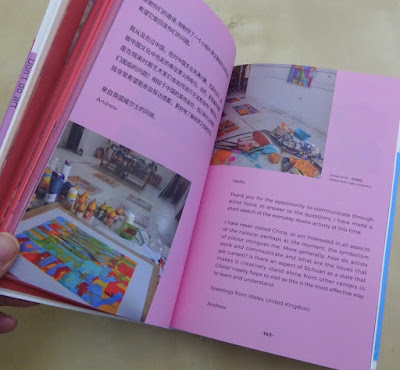

The kind of gesture I am concerned with is fluid spontaneous and fleeting. The movement is instinctive and unconscious; whilst making ones thinking is deliberately abstracted so that intention is absent and response is unguided in a cerebral way. The state is somewhere else. Getting to this point or place takes a little time and concentration, not just within a day but over the time of making, a week or two. It is definitely the studio thing; concentration to the point of transcendence, if that does not sound too pompous! But, to focus on the specific. What of gesture? It is a recording of the mind in motion. Certainly more to do with movement, process and journey rather than end point or product. It is possibly something akin to Zuihitsu, the Japanese method of writing that translates loosely as 'following the brush'. Another correlation with Zuihitsu is the element of fragmentation. Areas of colour are brought together as if by accident, parts are relating through juxtaposition rather than by design. As ever, the image is made only by a process that has no defined outcome. The element of gesture applies to many artists, Saura and de Kooning for example. However, with Saura and de Kooning there is a figurative cohesion; the gesture is part of the construction of a subject (a figure). My stance however is that the mark itself is the both the subject and the image.
Two new canvases were stretched from paintings made in the 1990s. I could not recall the dimension of these but the old paintings were removed and rolled. I am working through all my old large canvas stretchers and recycling these to make new work. It is such a good way to work. As usual 9oz cotton duck is stretched with three coats of rabbit skin glue and a thin oil based undercoat for all my oil paintings.
Reflective statement on #returntoconsciousness
Recent work over the past 18 months has been studio based and reflective of the international placements of the preceding 24 months. Taking as a point of reference, Jean Dubuffet’s notion of non-place (1), my practice has evolved through a parallel questioning of objectivity with a methodology using multiple 2D media exploring memory and experience of place. With diffused imagery there is an interrogation of reality, with dense clustering of line, shape and colour, intersecting graffiti like gestures and marks. Rhythm and repetition, spontaneity and design are all features of current drawings and paintings, an exploration of alternative reality.
(1) Barbican Art Gallery. Jean Dubuffet: Brutal Beauty current main exhibition May 2021



































































